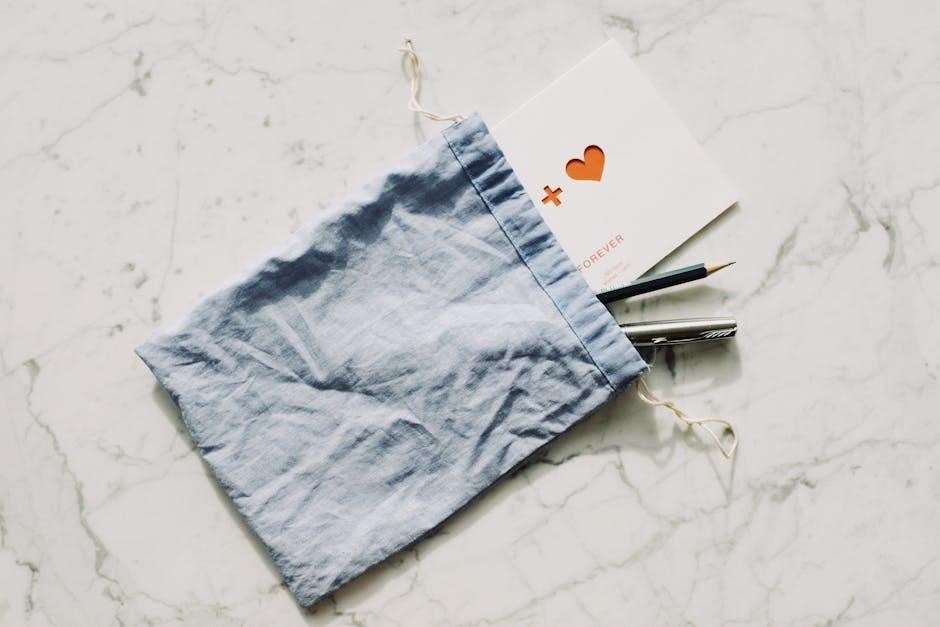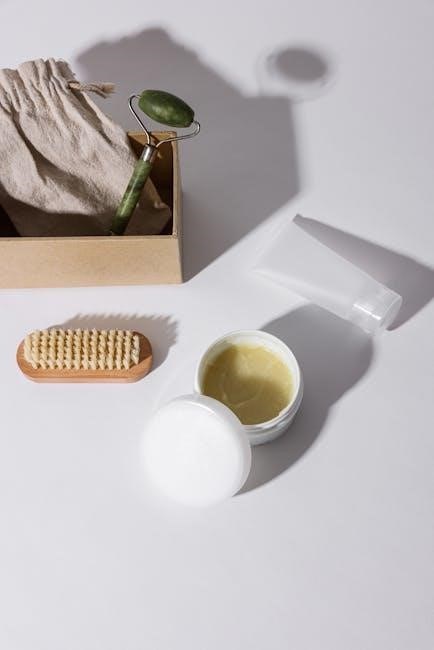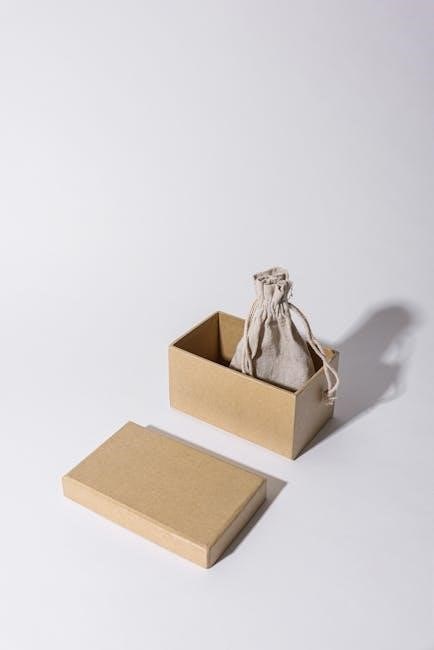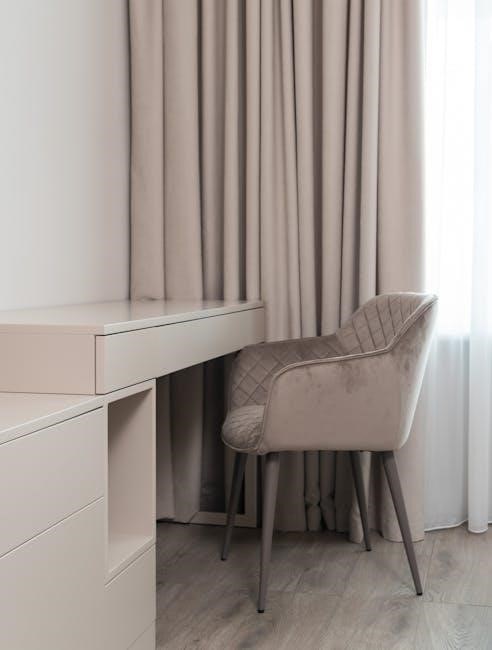
Lined zippered pouches are perfect for beginners, offering a fun and practical sewing project. They are great for using fabric scraps and can be customized to suit various needs, making them ideal for organizing small items.

Materials and Tools Needed
To create a lined zippered pouch, you’ll need a few basic materials and tools. Start with fabric scraps for both the exterior and lining—cotton fabrics work well. Choose a zipper that matches your pouch size, ideally 6-10 inches long for smaller pouches. You’ll also need a sewing machine, scissors, and a seam ripper for any adjustments. A measuring tape or ruler will help ensure accurate cuts, while pins will keep your fabric aligned during sewing. For a professional finish, consider adding interfacing or batting for stability. Optional tools include fabric paint, freezer paper, and an iron for custom designs. Gather these supplies, and you’ll be ready to start your project. The materials are affordable and easy to find, making this a great way to use up fabric scraps and create something functional and personalized.

Step-by-Step Sewing Guide
A lined zippered pouch involves cutting fabric pieces, sewing seams, and installing a zipper. Follow a beginner-friendly guide to create a professional finish, ensuring durability and style for your custom pouch.
3.1. Cutting Fabric Pieces
Cutting fabric pieces is the first step in creating a lined zippered pouch. Use fabric scraps or fat quarters for the main fabric and lining. Ensure both pieces are the same size, with a width slightly larger than the zipper. For a standard pouch, cut two main fabric pieces and two lining pieces. If using a 9-inch zipper, cut fabric pieces approximately 10 inches wide. Add optional interfacing or fleece for stability. Cut contrasting fabric strips for decorative accents, if desired. Place patterns on fabric, ensuring straight edges. Carefully cut along the lines using sharp scissors or a rotary cutter. Label each piece to avoid confusion during sewing. Organize the cut pieces, including the zipper, to prepare for assembly. This step sets the foundation for a polished, professional-looking pouch. By prepping fabric accurately, you ensure a smooth sewing process. Remember to save scraps for future projects or embellishments. Proper cutting ensures your pouch will be symmetrical and functional. Take your time to achieve precise cuts for the best results.
3.2. Sewing the Zipper
Sewing the zipper is a crucial step in constructing a lined zippered pouch. Begin by placing the zipper along the top edge of one of the main fabric pieces, ensuring it is centered and aligned with the raw edges. Pin the zipper in place, with the right side of the zipper facing the right side of the fabric. Use a zipper foot on your sewing machine to sew along the edge of the zipper, starting from the bottom and working your way up. Backstitch at the beginning and end for stability. Repeat this process for the other side of the zipper, attaching it to the corresponding lining piece. Ensure the fabric remains taut during sewing to avoid puckering. After sewing both sides, press the seams to flatten them and create a crisp finish. This step securely attaches the zipper, preparing it for the next stage of assembly. Proper alignment and even stitching are key to achieving a professional-looking zipper installation.

Customizing Your Pouch
Customizing your lined zippered pouch allows you to add personal touches and make it truly unique. Start by choosing vibrant fabrics or patterns that reflect your style. Adding appliqué, embroidery, or decorative stitching can elevate the design. For a polished look, use contrasting thread for topstitching or incorporate ribbons as accents. You can also attach small embellishments like tassels, buttons, or charms to give the pouch a distinctive flair.
Consider functional enhancements, such as adding internal pockets or compartments for better organization. Experiment with shapes by using rounded corners or angled edges for a modern aesthetic. Interfacing or stabilizers can add structure, making the pouch more durable. Personalize the pouch further by embroidering names or initials, perfect for gifting. With endless possibilities, customization transforms a simple pouch into a one-of-a-kind accessory tailored to your preferences or intended use.

Beginner Tips and Tricks
Starting with a lined zippered pouch can seem daunting, but with the right tips, it becomes a breeze. Always begin by selecting the right zipper size, as smaller zippers (6-10 inches) are easier to handle for beginners. Use fabric scraps to practice and experiment with different patterns and colors to add a personal touch.
When sewing the zipper, ensure it is centered and aligned properly with the fabric edges. Use a walking foot or Teflon foot for smooth sewing, especially if working with slippery fabrics. Press seams as you go to maintain a crisp finish. Don’t pull the fabric while sewing, as this can distort the pouch shape.
Take your time when sewing the zipper, as accurate alignment is key to a professional finish. Use pins to secure layers but avoid over-pinning, which can cause bulk. For a polished look, topstitch the edges after sewing. Lastly, don’t rush—each step builds on the last, and patience ensures a sturdy, functional pouch.
Uses and Applications
Lined zippered pouches are incredibly versatile and can be used for a wide range of purposes. They make excellent storage solutions for small items like makeup, jewelry, or electronics. Use them as a travel case for toiletries or as a protective pouch for your phone or earbuds.
These pouches are also great for organizing school supplies, crafting materials, or even as a first-aid kit. Their sturdy construction and durable lining make them ideal for everyday use. Additionally, they can serve as stylish clutches for special occasions or as gift bags for small presents.
Their compact size and customizable design make them perfect for personalizing gifts or creating functional accessories. Whether you need a practical storage solution or a fashionable accessory, a lined zippered pouch is a thoughtful and versatile choice for any occasion.

Advanced Sewing Techniques
For those looking to elevate their lined zippered pouches, advanced sewing techniques can add professionalism and uniqueness. One technique is installing zipper tabs, which provides a clean finish and reinforces the zipper ends. Another is creating a boxed bottom, giving the pouch a structured, stand-up design. Quilting or adding decorative stitching can enhance the pouch’s visual appeal and add texture.
Using contrasting fabrics for the lining and exterior creates a stylish, customizable look. Additionally, incorporating interfacing or stabilizer ensures durability and shape retention. Advanced sewists might also explore adding decorative elements like appliqué or embroidery for a personalized touch. For a polished finish, consider sewing bias binding over seams or adding leather accents for a sophisticated vibe. These techniques not only refine the pouch’s appearance but also demonstrate mastering intermediate to advanced sewing skills. By experimenting with these methods, sewists can create truly unique and professional-looking lined zippered pouches.

Troubleshooting Common Issues
When sewing a lined zippered pouch, common issues may arise, but they are easy to resolve. One frequent problem is the zipper not aligning properly, which can be fixed by ensuring the fabric edges are evenly matched and the zipper is centered. Another issue is fabric bunching during sewing, often caused by uneven tension; using a walking foot or Teflon foot can help. If the seams don’t match up perfectly, double-check your cutting measurements and pin alignment. Additionally, if the lining doesn’t fit smoothly inside the pouch, inspect the seam allowances and ensure they are consistent. For zippers that stick or don’t close smoothly, applying a small amount of silicone spray or wax can resolve the issue. Lastly, if the pouch lacks structure, consider adding interfacing or stabilizer to the fabric before sewing. By addressing these common challenges, you can achieve a professional-looking pouch with ease.
Sewing a lined zippered pouch is a rewarding and versatile project that offers endless possibilities for customization. Whether you’re a beginner or an experienced sewer, this pouch is a great way to practice working with zippers and linings while creating something functional and stylish. The process is straightforward, and with a few simple tools and materials, you can craft a pouch that suits your needs or makes a thoughtful gift. Many creators find joy in transforming fabric scraps into something beautiful and useful, making this project not only practical but also environmentally friendly. Once you master the basics, you can experiment with different sizes, shapes, and embellishments to create a unique collection. With patience and practice, you’ll be making professional-looking lined zippered pouches in no time. Happy sewing, and enjoy the satisfaction of creating something truly handmade!
Additional Resources
For further guidance and inspiration, there are numerous online resources available to help you refine your lined zippered pouch skills. Websites like Notches Sewing and Needlepointers.com offer detailed tutorials and free patterns to enhance your projects. Additionally, platforms like Pinterest and YouTube provide a wealth of video tutorials and step-by-step guides, perfect for visual learners. Many sewing blogs, such as Melanie Kham, share tips for customizing your pouches and overcoming common challenges. If you’re looking for advanced techniques, consider exploring patterns that include features like boxed bottoms or contrasting stripes. Online sewing communities are also a great way to connect with other crafters, share ideas, and learn from their experiences. With so many resources at your fingertips, you can continue to grow your skills and create even more unique and functional lined zippered pouches.